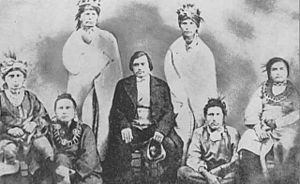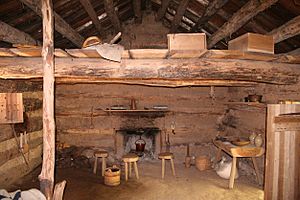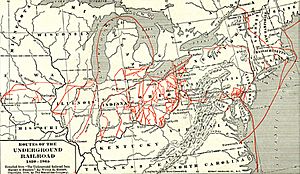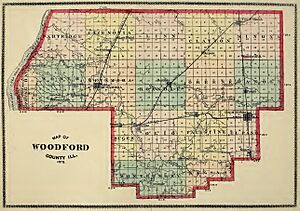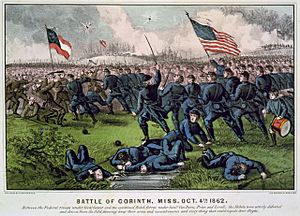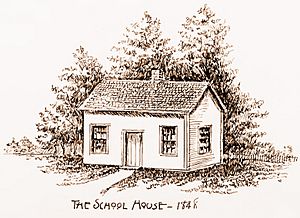Woodford County, Illinois facts for kids
Quick facts for kids
Woodford County
|
|
|---|---|
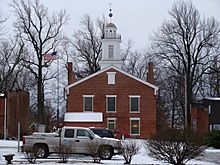
|
|
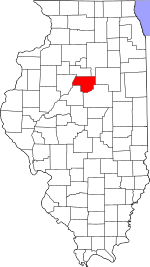
Location within the U.S. state of Illinois
|
|
 Illinois's location within the U.S. |
|
| Country | |
| State | |
| Founded | February 1841 |
| Named for | Woodford County, Kentucky |
| Seat | Eureka |
| Largest city | Eureka |
| Area | |
| • Total | 543 sq mi (1,410 km2) |
| • Land | 528 sq mi (1,370 km2) |
| • Water | 15 sq mi (40 km2) 2.7% |
| Population
(2020)
|
|
| • Total | 38,467 |
| • Estimate
(2021)
|
38,225 |
| • Density | 70.84/sq mi (27.352/km2) |
| Time zone | UTC−6 (Central) |
| • Summer (DST) | UTC−5 (CDT) |
| Congressional district | 16th |
Woodford County is a place in the state of Illinois, USA. It's like a smaller region within the state, similar to a district. In 2020, about 38,467 people lived here. The main town, or county seat, where the county government is located, is Eureka. Woodford County is part of the larger Peoria area. It was named after General William Woodford, a brave officer who fought in the American Revolutionary War.
Contents
History of Woodford County
How Woodford County Started
Long ago, the land that is now Woodford County was home to several Native American groups. These included the Potawatomi, Meskwaki, and Sauk peoples. There's a lot of old evidence, like artifacts, showing that many First Nations people lived here.
When America was first forming, three colonies, Massachusetts, Virginia, and Connecticut, all claimed parts of Illinois. In 1778, Virginia created a huge area called Illinois County. Later, in 1809, Illinois Territory was officially set up by the United States. Illinois became a state in December 1818.
The first American settlers started arriving in what is now Woodford County in the 1820s. The very first settlement was at Spring Bay. Pioneers chose this spot because it was close to the Illinois River.
The county's borders and names changed many times in the early days. For example, the eastern part of Woodford County was called Edwards, Crawford, Clark, and Fayette Counties at different times. The western part was known as Madison, Bond, and Sangamon Counties.
In 1827, new lines were drawn, and Tazewell County was created, which included all of today's Woodford County. More settlers arrived in the early 1830s. This led to Woodford County being officially created with its current borders in February 1841.
The county was named after Woodford County, Kentucky. That Kentucky county was named after General William Woodford. He served with General George Washington at Valley Forge, Pennsylvania, during the very cold winter of 1777-78.
The first post office in Woodford County opened in 1836 in Partridge township. It was named after a local Native American leader, Black Partridge. The first school, a private one, also started that year. A public school followed soon after.
Life as a Pioneer
The first settlers in Woodford County lived in simple log cabins. They filled the gaps between the logs with clay to keep out the cold wind. Windows were often made of oiled paper, and doors and floors were rough wooden boards. These cabins usually had just one room, heated by a fireplace.
Pioneers often cooked meat over a fire. Since many cabins didn't have ovens, cornbread was baked directly on the fireplace coals. Waffles were a common food, cooked in a long iron mold. In winter, people mostly ate bread and meat. Vegetables like pumpkin, red peppers, and corn were dried for later use.
Clothes were made at home, often from linen grown on their farms. Heavier fabrics like "linsey" (made of linen or cotton with wool) and "jeans" (a thick, brown material dyed with walnut bark) were also used.
Before 1831, all wool had to be prepared by hand. People used special boards with metal spikes to "card" the wool. Then, they spun it into thread on a spinning wheel to prepare it for weaving on a loom.
Men usually worked in farming, hunting, and building. Women focused on making things for the home and preparing food. Farming was the most important job because much of Woodford County's land was good for growing crops. Farmers used wooden plows and planted corn by hand. Hay was cut with a scythe and gathered with rakes and pitchforks.
Later, as timber mills appeared, people started building frame houses. Neighbors helped each other build homes and barns. Building a large barn was hard and dangerous work that needed everyone's help. Other buildings included stables, corn-cribs, and smokehouses. Wooden fences became common in the 1850s.
In the early days, people voted by voice, not with secret ballots.
Years Before the Civil War
By the late 1840s, Woodford County had many settlers, with over 5,000 people living there. Most people in Illinois were against slavery. When the Fugitive Slave Act of 1850 was passed, which made it harder for enslaved people to escape, many residents became upset. They started helping enslaved people escape to freedom in Canada. One path of this secret network, called the Underground Railroad, went right through Woodford County.
The "stations" of the Underground Railroad were safe houses where escaping enslaved people could eat and sleep. These houses were placed at distances that allowed travelers and their "conductor" guides to move from one to the next in a single night.
The journey was very dangerous. Slave owners offered rewards for runaway enslaved people, which attracted bounty hunters. Also, anyone who helped enslaved people escape was breaking the law and could be punished.
Local church leaders, Mr. Dutton and Parker Morse, were known for leading the anti-slavery efforts in the area.
Early County Government
When Woodford County was first created in 1841, the county seat was temporarily in Versailles for two years. Many towns wanted to be the county seat because it brought more business. In June 1843, Metamora (then called Hanover) was chosen as the new main town. A county courthouse was started in Metamora in 1844, and a jail was finished there in 1852.
During the years before the Civil War, Woodford County decided to divide itself into smaller areas called townships. Some people were against this idea. It took four public elections between 1850 and 1854 before the township system was finally approved.
After the county was divided into townships in 1855, the government changed. A county commission was replaced by a new group called the board of supervisors. Early county officials, like the sheriff and treasurer, were elected for two-year terms, which later changed to four years.
Other towns, like Eureka, El Paso, and Roanoke, also tried to become the county seat. In 1867, El Paso almost succeeded by offering Metamora $30,000 to move the county seat. A close vote was reversed by just 10 votes after a recount.
Another vote in 1869 rejected moving the county seat to Eureka. A questionable recount in a third election in November 1873 again overturned a vote to move the seat to Roanoke. A fourth election in 1884, also for Roanoke, failed. Finally, in 1894, a clear majority voted to move the county seat to Eureka.
A new, impressive courthouse was quickly built in Eureka, making it the permanent center of Woodford County's government.
Civil War Times
By the start of the American Civil War in 1861, Woodford County's population had grown to 13,281. People in the county strongly supported the Union. By the end of the war, about 1,643 men from Woodford County served in the army against the Confederate States of America. This was 12.4% of the county's total population.
States were asked to provide a certain number of soldiers based on their population. People who joined the army received bonuses. After 1862, if not enough people volunteered, a draft was started. People who were drafted could pay someone else to take their place, sometimes for as much as $1,000.
Woodford County soldiers served in many different army units. Some units had many men from Woodford County. For example, Company G of the 17th Illinois Volunteer Infantry Regiment fought in the bloody Battle of Shiloh in April 1862. Several Woodford County men were among those killed or wounded. This unit also helped in the 1863 Siege of Vicksburg, which led to the surrender of over 29,000 Confederate soldiers.
Another unit with many Woodford County men was the 47th Illinois Volunteer Infantry Regiment. They suffered many losses in the Battle of Corinth, Mississippi, in October 1862. They also had many casualties in May 1863 during the Vicksburg Campaign.
The 77th Illinois Volunteer Infantry Regiment also had many Woodford County men. They fought in the early parts of the Vicksburg Campaign and later in the Battle of Jackson, Mississippi. However, in April 1864, they faced a disaster at the Battle of Sabine Cross-roads in Louisiana. Many were killed, wounded, or captured. The unit was finally discharged in July 1865, after fighting in 16 battles.
Woodford County men also served in the 86th Illinois Volunteer Infantry Regiment, fighting at the Battle of Perryville and later joining Sherman's March to the Sea. Others were in the 108th Illinois Volunteer Infantry Regiment, where most deaths were from disease, not combat.
Eureka College
For over 150 years, Eureka College has been an important part of Woodford County. It's a college connected to the Christian Church (Disciples of Christ). A very famous student who went there was President Ronald Reagan.
Eureka College began in 1848. A young college student named A.S. Fisher wanted to start a school in Walnut Grove (which is now Eureka). He wanted to teach subjects like language, science, math, and philosophy. Local people helped pay his salary, and the school officially opened in September 1848 in a small building.
Because of a popular religious leader, the Church of Christ grew a lot. People wanted the school to become a seminary, a place where students from other areas could live and study. In September 1849, the school was renamed Walnut Grove Seminary. A.S. Fisher was the principal, helped by a talented young woman teacher. Fisher worked with the college for 38 years.
The school changed its name again in December 1849 to Walnut Grove Academy. Money was raised to build a new two-story building.
The idea for the school kept growing. People started planning and raising money to turn the academy into a full college with buildings and a library. They asked the Church of Christ's Missionary Convention for help in 1851, and many church members became excited about creating a college.
Geography and Climate
Woodford County covers about 543 square miles. Most of this area, 528 square miles, is land, and 15 square miles (2.7%) is water. The county is mostly prairie land, which means flat grasslands. Some higher areas used to be covered with trees.
Weather in Woodford County
| Weather chart for Eureka, Illinois | |||||||||||||||||||||||||||||||||||||||||||||||
|---|---|---|---|---|---|---|---|---|---|---|---|---|---|---|---|---|---|---|---|---|---|---|---|---|---|---|---|---|---|---|---|---|---|---|---|---|---|---|---|---|---|---|---|---|---|---|---|
| J | F | M | A | M | J | J | A | S | O | N | D | ||||||||||||||||||||||||||||||||||||
|
1.8
30
13
|
1.8
36
18
|
3.2
48
29
|
3.5
62
38
|
4.2
73
49
|
3.7
83
58
|
3.8
86
62
|
3.4
84
60
|
3.3
78
52
|
2.8
66
41
|
3.3
49
30
|
2.4
35
19
|
||||||||||||||||||||||||||||||||||||
| temperatures in °F precipitation totals in inches source: The Weather Channel |
|||||||||||||||||||||||||||||||||||||||||||||||
|
Metric conversion
|
|||||||||||||||||||||||||||||||||||||||||||||||
In Eureka, the county seat, average temperatures range from 13°F (about -11°C) in January to 86°F (about 30°C) in July. The coldest temperature ever recorded was -28°F (-33°C) in February 1905. The hottest was 111°F (44°C) in July 1936. The county gets the most rain in May, with about 4.20 inches (10.7 cm). January is the driest month, with about 1.75 inches (4.4 cm) of rain.
Main Roads
 Interstate 39
Interstate 39 Interstate 74
Interstate 74 U.S. Highway 24
U.S. Highway 24 U.S. Highway 51
U.S. Highway 51 U.S. Highway 150
U.S. Highway 150 Illinois Route 26
Illinois Route 26 Illinois Route 89
Illinois Route 89 Illinois Route 116
Illinois Route 116 Illinois Route 117
Illinois Route 117 Illinois Route 251
Illinois Route 251
Neighboring Counties
- Marshall County (north)
- LaSalle County (northeast)
- Livingston County (east)
- McLean County (southeast)
- Tazewell County (southwest)
- Peoria County (west)
People of Woodford County
| Historical population | |||
|---|---|---|---|
| Census | Pop. | %± | |
| 1850 | 4,415 | — | |
| 1860 | 13,282 | 200.8% | |
| 1870 | 18,956 | 42.7% | |
| 1880 | 21,620 | 14.1% | |
| 1890 | 21,429 | −0.9% | |
| 1900 | 21,822 | 1.8% | |
| 1910 | 20,506 | −6.0% | |
| 1920 | 19,340 | −5.7% | |
| 1930 | 18,792 | −2.8% | |
| 1940 | 19,124 | 1.8% | |
| 1950 | 21,335 | 11.6% | |
| 1960 | 24,579 | 15.2% | |
| 1970 | 28,012 | 14.0% | |
| 1980 | 33,320 | 18.9% | |
| 1990 | 32,653 | −2.0% | |
| 2000 | 35,469 | 8.6% | |
| 2010 | 38,664 | 9.0% | |
| 2020 | 38,467 | −0.5% | |
| 2023 (est.) | 38,285 | −1.0% | |
| US Decennial Census 1790-1960 1900-1990 1990-2000 2010-2013 |
|||
In 2010, there were 38,664 people living in Woodford County. Most people (97.4%) were White. About 1.4% of the population was of Hispanic or Latino background. Many residents have German (48.7%), Irish (14.1%), or English (10.9%) family roots.
About 34.8% of households had children under 18. The average household had 2.64 people. The average age in the county was 39.6 years old.
The average income for a household was $65,890. For families, it was $75,601. About 7.0% of the population lived below the poverty line. This included 10.6% of those under 18.
How Woodford County is Governed
Woodford County is run by a County Board with 15 elected members. Each member serves for four years. The board members choose one person to be their leader, called the chair, every two years. The County Board makes rules for the county, decides on the budget, collects taxes, and sets policies for how the government works. They meet every month. They also choose five smaller groups, called standing committees, each with five members, who also meet monthly.
The 15 board members are elected from three different areas, or districts. Each district elects five board members.
Education in Woodford County
Schools for Kids (K-12)
Woodford County has several school districts that serve students from kindergarten through 12th grade:
- Deer Creek-Mackinaw Community Unit School District 701
- El Paso-Gridley Community Unit School District 11
- Eureka Community Unit District 140
- Fieldcrest Community Unit School District 6
- Lowpoint-Washburn Community Unit School District 21
- McLean County Unit School District 5
- Olympia Community Unit School District 16
- Roanoke-Benson Community Unit School District 60
There are also specific high school and elementary school districts:
- Metamora Township High School District 122 (for high school)
- Germantown Hills School District 69 (for elementary school)
- Metamora Community Consolidated School District 1 (for elementary school)
- Riverview Consolidated Community School District 2 (for elementary school)
- High Schools
- El Paso-Gridley High School (in El Paso)
- Eureka High School (in Eureka)
- Fieldcrest High School (in Minonk)
- Lowpoint-Washburn High School (in Washburn)
- Metamora Township High School (in Metamora)
- Roanoke-Benson High School (in Roanoke)
Media and News
In the early days, Woodford County had many newspapers. The first was probably the Woodford County Times in 1854. By 1880, there were five weekly newspapers: Woodford Sentinel, El Paso Journal, Eureka Journal, Minonk Blade, and Washburn News. Eureka College also published a monthly magazine called the Eureka College Messenger.
Famous People from Woodford County
- Donald Attig (born 1936), boat designer, went to Eureka College.
- Emik Avakian (1923-2013), inventor, graduated from Eureka College in 1948.
- Emma Smith DeVoe (1848-1927), a leader for women's voting rights, taught at Eureka College.
- J. Frank Duryea (1869-1967), helped invent the gas-powered car, born in Washburn.
- Frank Frantz (1872-1941), a Rough Rider and governor, attended Eureka College.
- Glen Gray (1900-1963), jazz musician, born in Roanoke.
- Oliver Perry Hay (1846-1930), professor and expert on ancient animals, graduated from Eureka College.
- John S. Kyser (1900-1975), university president, born in El Paso.
- Dan McCoy (born 1978), comedian and TV writer, graduated from Eureka High School.
- Ralph "Mac" McKinzie (1894-1990) coached football at Eureka College for 17 seasons.
- Mary Frances Winston Newson (1869-1959), mathematician, taught at Eureka College.
- William A. Poynter (1848-1909), 10th Governor of Nebraska, born in Eureka, graduated from Eureka College.
- Neil Reagan (1908-1996), advertising executive and brother of Ronald Reagan, graduated from Eureka College.
- Ronald Reagan (1911-2004), 40th President of the United States, graduated from Eureka College.
- Junius P. Rodriguez (born 1957), historian, professor at Eureka College.
- Fulton J. Sheen (1895-1979), Catholic archbishop and TV speaker, born in El Paso.
- Andy Studebaker (born 1985) NFL football player, graduated from Eureka High School.
- Caleb TerBush (born 1990), college football player, graduated from Metamora Township High School.
- Ben Zobrist (born 1981), All-Star Major League Baseball player, born and raised in Eureka.
Images for kids
Townships
- Cazenovia Township
- Clayton Township
- Cruger Township
- El Paso Township
- Greene Township
- Kansas Township
- Linn Township
- Metamora Township
- Minonk Township
- Montgomery Township
- Olio Township
- Palestine Township
- Panola Township
- Partridge Township
- Roanoke Township
- Spring Bay Township
- Worth Township
Communities
Cities
- El Paso (partly in McLean County)
- Eureka (County Seat)
- Minonk
Villages
- Bay View Gardens
- Benson
- Congerville
- Deer Creek (partly in Tazewell County)
- Germantown Hills
- Goodfield (partly in Tazewell County)
- Kappa
- Metamora
- Panola
- Peoria Heights (mostly in Peoria County)
- Roanoke
- Secor
- Spring Bay
- Washburn (partly in Marshall County)
Unincorporated Communities
See also
 In Spanish: Condado de Woodford (Illinois) para niños
In Spanish: Condado de Woodford (Illinois) para niños


